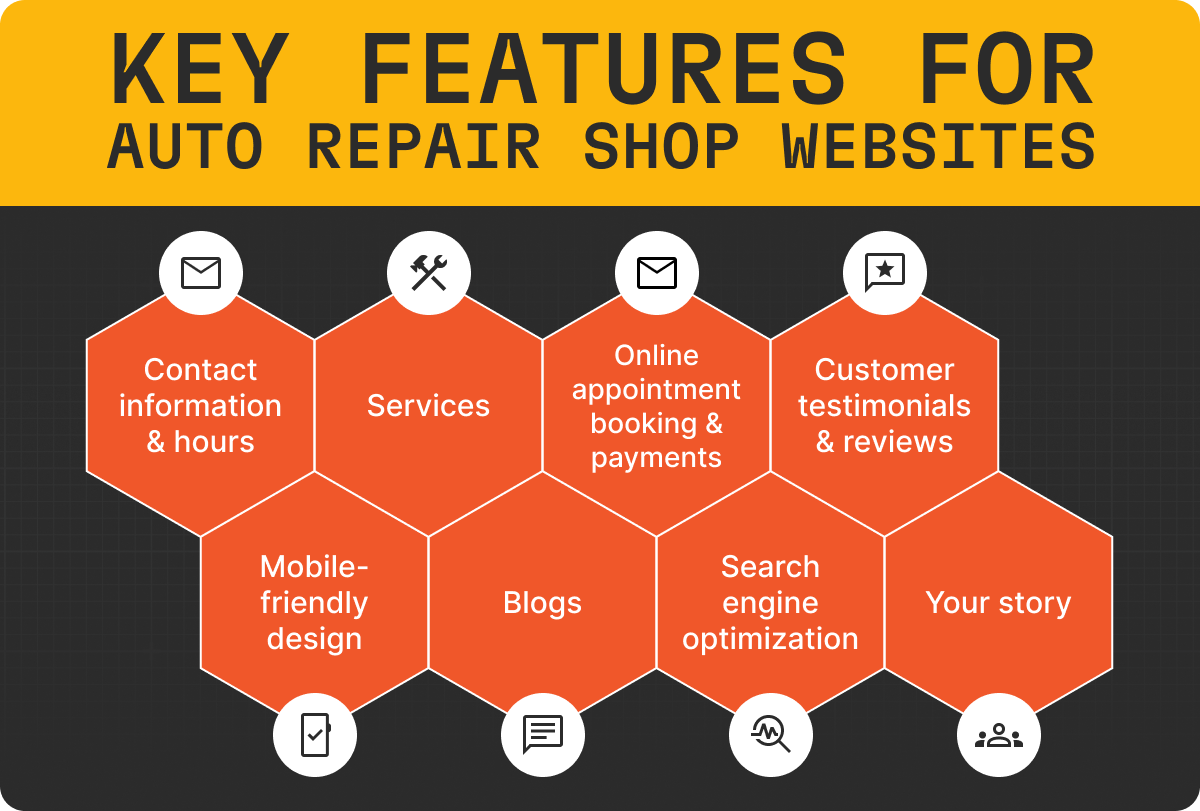Choosing the best auto repair software for your shop is essential for staying competitive in today’s digital landscape. While many shops are adopting digital solutions, the variety of options for the top auto shop software can make the choice overwhelming. To find success, it is important to identify a solution that aligns seamlessly with your business goals and strategy.
What is Auto Repair Shop Software?
Auto repair software is a digital tool shop owners can use to streamline workflows and help with daily tasks like invoices, reporting, and payments. These softwares are designed to make shops run smoother and reduce headaches. Each software has a unique set of features and functionality. This guide was created to help you find the best shop management software and compare and contrast features.
Benefits of Auto Repair Software
Auto repair software can offer a lot of benefits for your shop including:
- Reduced back and forth with customers through two-way texting.
- Quicker inspections leading to more vehicles per day.
- More secure files through cloud-based software versus pen and paper.
- Automated tasks take less time like parts ordering and repair order creation.
- Increased visibility of how your business is doing through real-time dashboards.
- Keep track of customer notes, names, and vehicle history in one place.
All of these benefits improve efficiency in your shop leading to more revenue. Plus, your staff will be able to do more in less time making their lives easier.
Top Shop Management Software Features to Look For
The solution you use in your shop should offer a comprehensive suite of features to streamline operations, enhance your customer experience and increase profitability. These features might take on several forms, so look for options that fall into one of the following five categories:
- Security Features
- Convenience Features
- Trust Features
- Efficiency Features
- Expansion Features
Security Features
The best automotive repair shop software is one that prioritizes security. Your shop collects tons of data both internally and externally each day. Not only do you store information on your shop’s productivity and financial performance, but vehicle owners also entrust you with their personal information. In all cases, that information should be stored safely and protected by your software solution. Some key features to look for include:
- Cloud-based. Cloud-based systems are one of the most secure solutions available. Not only is the data stored in a cloud-based system available to you anytime, anywhere, but it is also regularly backed up to provide an additional layer of protection against unforeseen events like natural disasters or equipment failures.
- Third-party security certification. Third-party certifications validate a shop management system’s commitment to data protection. Tekmetric recently achieved SOC II Type 2 Compliance, demonstrating its dedication to safeguarding customer data in five areas: security, availability, processing integrity, confidentiality and privacy.
Convenience Features
When customers have an excellent, convenient experience, they are more likely to return to your shop for future repairs. The best car repair software you can use in your shop helps you personalize the customer experience for your target audience and improve customer communication. Here are some customer-centric features to consider:
- Digital payment solutions. With features like integrated payments, buy now pay later and text-to pay, customers can pay in a manner that works best for them, allowing them to pick up their car after hours, pay invoices from their office and even complete a payment for their college student from states away.
- Two-way texting. Two-way texting features can streamline communications, allowing your team to easily text with customers. With two-way texting, you can even designate your shop’s existing landline number as the contact to avoid confusion.
- Automation. With automation-based features like SmartJobs, your service advisors can create jobs in only one or two clicks, allowing them to focus less on manual tasks and more on interacting with customers.
Trust Features
In the auto repair industry, creating customer loyalty is critical for differentiating your shop and driving business. Your customers will keep coming back if they trust your team and the services you provide. As you search for the best shop management software for your shop, look for a solution that helps you increase transparency and build trust with new and existing customers alike. Some features might include:
- Digital vehicle inspections. DVIs allow technicians to complete a comprehensive inspection of the vehicle and send customers pictures and videos of any repairs it might need. This strategy helps customers better understand what is happening with their vehicle, making them more likely to agree to necessary repairs.
- Educational integrations. Some integrations can help educate your customers on the necessity of a repair or how their vehicle should work. With Tekmetric’s integration with MotoVisuals, for example, customers can view animated videos of proposed repairs that explain why these repairs are vital for their vehicle. This creates a seamless experience for your customers while building trust and strengthening the relationship.
Efficiency Features
In addition to providing secure data storage and enhancing your customer experience, investing in auto repair software can also help your mechanic shop run more efficiently. The best auto repair software for you should offer customizable functionality that streamlines your internal processes and workflow to help you finish repairs on time. Here are some features that promote efficiency:
- Inventory orders. In addition to building the estimates, a comprehensive shop management system can support your team in ordering parts and managing inventory. Tekmetric has created an inventory management solution that enables your technician to order parts as they are completing the repair diagnosis. This streamlines the work order process and removes any potential miscommunications between technicians and managers or service advisors ordering parts, leading to a more accurate and efficient process.
- Automatic progress updates. Tekmetric automatically updates new notes within a repair order for all team members to view the updates as soon as they are entered. Service advisors can then automatically send these updates to the customer, so the customer remains informed even if the service advisor is occupied with another task. With automatic updates, the customer has a play-by-play of the repair – and they can complete the next task, such as approval or payment, without any back-and-forth over the phone or having to come in person.
- Mobile App for 24/7 access. A mobile app can help your technicians perform inspections faster and be able to take pictures/videos right from their device. Mobile apps can also help shop owners check on reporting and dashboards while away from their desks.
- Shop dashboard real-time reporting. Reviewing dashboards in real-time allows you to respond to potential bottlenecks or problems that arise throughout the day. For example, you can review your profitability early in the week and determine if you’re on the right path or if you need to take steps such as calling customers for approvals or following up on declined work to generate more repairs.
Expansion features
One common mistake shop owners make is buying an auto repair shop management software that only meets their current needs. The best auto repair softwares grow with your business and can integrate with other products.
- Integrations. Each auto repair shop is unique and has different needs. In addition, each shop will grow and have new emerging needs down the road. Purchase an auto repair shop software that meets your current needs and can integrate with other features you will need later on. Ask fellow shop owners which integrations they find helpful and learn from their success.
- Multi-Location. If you are a shop owner with a vision to expand into multiple locations, make sure your auto repair software can handle the task. Tekmetric offers multi-shop management where you can view all of your reports in one place and streamline your workflow across locations.
- New Services and Products. Do you envision your shop offering tires or other products in the future? Not all auto repair softwares are built equal, so make sure your software is up the task.
What is the best auto repair shop software?
The best automotive repair shop software for you is one that allows you to run your business smoothly while also supporting security, convenience and transparency between you and your customers. When your software supports these areas, you will be better poised to streamline your shop’s processes and create a better customer experience – ultimately driving your bottom line.
Choosing a software is a personal decision based on your specific business strategy, budget, customers and team. Fortunately, many softwares have advanced features that can be customized to your goals and needs. These advanced features come at a price and each software has differing pricing plans. Make sure your research includes pricing and what the ROI will be for your shop.
Final Thoughts
When researching the right shop management solution for your shop, look for the right features to meet your needs and workflow. Another expert tip is to utilize unbiased review platforms like G2 to discern which software is best for you. Lastly, network and connect with fellow shop owners and see what they recommend.



.png)
.png)





.svg)



.svg)